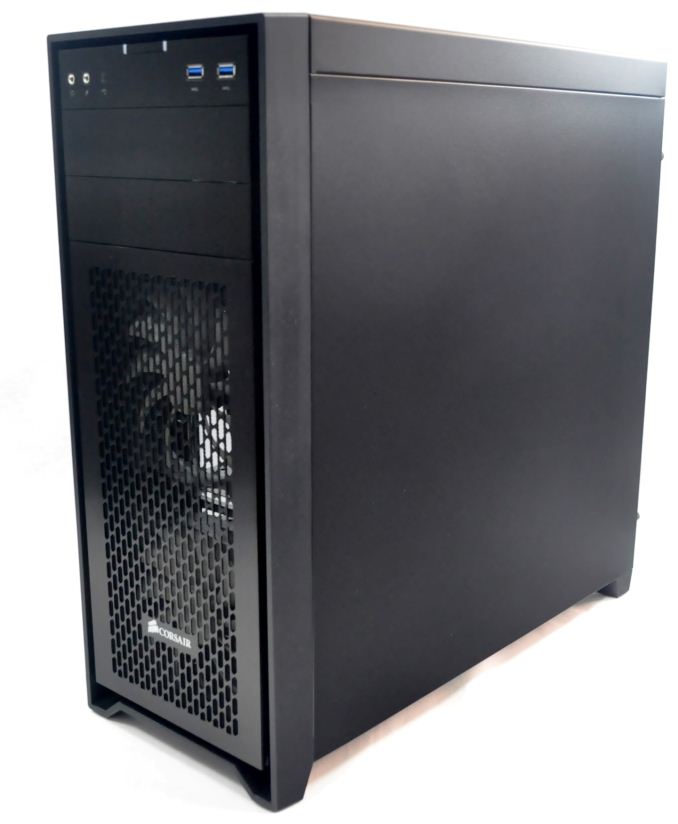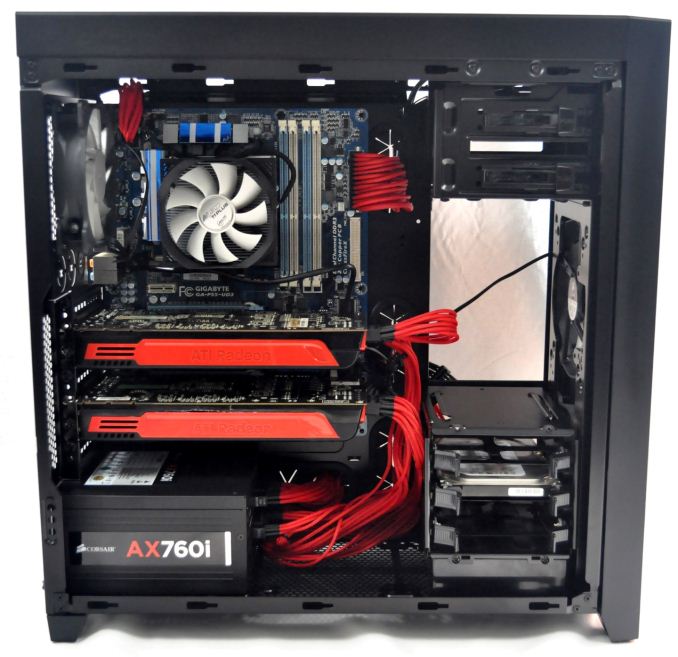Corsair Obsidian 450D Case Review
by E. Fylladitakis on April 4, 2014 6:00 AM EST- Posted in
- Cases/Cooling/PSUs
- Corsair
- mid-tower
- Case
Final Words
With the Obsidian 450D, Corsair attempted to fill the gap between the Micro-ATX 350D and the very large 750D of the same series with a mid-tower case of normal proportions. Yes, they already have half a dozen mid-tower cases available, such as the Graphite 230T and the Carbide 300R, but only the 650D / 550D are part of the Obsidian series and they have been engineered with entirely different target groups in mind. The Obsidian 450D is a normal sized mid-tower case designed to deliver flexibility and cooling for a reasonable retail price. Considering the variety of cooling options that may be applied and the additional flexibility that the removable drive cage offers, the Obsidian 450D does very well in terms of versatility, within the boundaries of a mid-tower design of course.
The thermal performance of the Obsidian 450D definitely is to be reckoned. Even with the slow-spinning stock fans, the heavily perforated chassis of the Obsidian 450D allows heat to escape towards virtually all directions if required. As such, the thermal performance of the Obsidian 450D is unusually high for a mid-tower ATX design. On the other hand, these many openings have the exact opposite effect when it comes to noise suppression; they do nothing to stop noise from exiting the chassis.
The stock cooling of the Obsidian 450D is very good in terms of acoustics performance, with the fans being only slightly audible even while running at maximum speed; however, although the noise figures are very low for a case with so many openings, even with the fans running at maximum speed, the noise of everything installed inside the Obsidian 450D (e.g. GPUs, CPU coolers, etc.) will not be damped in the slightest. Corsair obviously did not design Obsidian 450D with minimal noise operation in mind; it wouldn't make much sense to do so either, as they already had the Obsidian 550D available for that purpose.
In terms of design, the Obsidian series consists of Corsair's most serious and elegant products. They have not been created so as to stand out via an aggressive appearance or strong lighting; the Obsidian series cases lure the attention of spectators through their clean, refined design. The post-minimalistic design of the 450D is undoubtedly a perfect match for the Obsidian series. Uniqueness however is an entirely different story; the Obsidian 450D is essentially a larger 350D or smaller 750D, as all three of these cases share the same design. Even the cubic 250D and the massive 900D share a similar core design, with the distinguishable dissimilarities being due to their much different shape. If the 450D had no perforated front intake cover, it could be easily mistaken for a 350D, even though the latter is significantly shorter.
The MSRP of $119 is reasonable for an Obsidian series case, especially considering that the similarly sized 650D retails for nearly twice the price. However, there are multitudes of similarly sized and less expensive products available, some of which offer the Obsidian 450D strong competition. Even Corsair's own products, such as the Carbide 500R and 300R, are possible opponents for the Obsidian 450D, as they too offer good cooling options and versatility. We however believe that the strongest feature of the Obsidian 450D is its graceful, clean appearance, which will surely attract a significant number of consumers all by itself.
In summary, the Obsidian 450D delivers great cooling performance and a clean aesthetic at a moderately high price. Those who have eyed the Obsidian 350D in the past and wanted something a bit larger (but not as large as the 650D) will be pleased with what it offers. Corsair continues to make cases that are easy to work with and have all the necessary features, and the 450D is no exception. While it's not the best fit for a low-noise solution, enthusiasts and gamers will have plenty to work with.












36 Comments
View All Comments
lmcd - Friday, April 4, 2014 - link
I think a reference article suggesting one generic system the test loads would be equal could help?It's tough to envision where these thermal dissipations fall in with the market.
vgray35@hotmail.com - Saturday, April 5, 2014 - link
I do not concur with your reasoning in large part. Yes comparisons are excruciatingly difficult, and in many instances possibly even impossible to construe reasonable conclusions. So what! Comparisons are not everything. Comparisons are difficult yes, but nevertheless a figure of merit in the form of a specific test case gives an idea of what the Case design is capable of achieving, quite apart from the rudimentary machinations of comparing results. We have a need for comparisons to some extent n you constant heat load idea will help here, but we also have a need for a SPECIFIC perspective on Case design. Specific test results are not invalid just because comparisons are difficult. Once I have chosen a specific Computer Case for a build, I use the specific test case as a representative example of internal case design, in terms of airflow and specific components. I am then no longer interested in comparisons.Difficulty in comparing results in no wise invalidates the usefulness of a specific test case, somehow making it useless. Measuring total heat load for a specific test case with CPU etc, temperature rises, is just that - a specific test case - that is not invalidated by some different testing methodology. It remains a real world test - just a SPECIFIC case test, comparisons aside. A single snapshot view and heat load example is not useless expressed in the form of specific components and temperature differentials.
Applying a constant heat load is a good idea as an alternative test, but you reach too far when you declare specific test cases are invalid, just because comparisons of specific test cases are difficult.They provide a figure of merit of one sort, and these are not necessarily intended to be compared with other results. Difficulty in comparisons is not a legitimate reason for abandoning specific test cases, as comparisons are not the holy grail of these results.
I like the notion that: "these specific components loaded to this specific heat load produces a specific series of temperature differentials with this specific Case and components". For example I may want to build the specific test case with only minor changes, and the impact of making the minor changes is what is of interest - not comparisons with other specific tests.
The whole gamut of your methodology intimates that "comparisons are impossible to make", and therefore specific test cases are invalid. That is wrong. Yes settings change things a lot - so just measure input power and temperatures and be done with it. Specific test cases serve much more beyond merely being used for comparison purposes, which makes them valid real world test cases.
vgray35@hotmail.com - Saturday, April 5, 2014 - link
Guess what! real work includes interacting with your client base. Reading review comments constitutes a part of your real word job.FriendlyUser - Friday, April 4, 2014 - link
Great review! I'd really like to see a similar review of the 750D one day, since I'm interested in more spacious enclosures.HisDivineOrder - Friday, April 4, 2014 - link
I wish Corsair would iterate on the 550D with a cube-shape. That'd be hot as an Obsidian product. The current Corsair cube leaves much to be desired.rpjkw11 - Friday, April 4, 2014 - link
I really like Corsair's use of magnetic dust filters, but not on the bottom as in this case. Tipping a case to remove a dust filter for cleaning is, according to Murphy's Law, an accident waiting to happen. That's nitpicking, true, but one little Ooops can ruin one's day, so for me at least, it's a deal breaker. Except for that, the 450D is a great looking, very well designed case.kmmatney - Friday, April 4, 2014 - link
You don't have to tip the case to get the bottom filter - you can use a screw driver to pop it off, or even just your fingers. Well worth it for a dust-free case.FoRealz - Friday, April 4, 2014 - link
Can you please list the weight of the cases? Many thanks!E.Fyll - Friday, April 4, 2014 - link
Yes, I will in future reviews, I just received a proper scale that was bought for that specific purpose.Subyman - Friday, April 4, 2014 - link
It seems Corsair keeps stepping down the quality of plastics they use. The front facia looks like really cheap plastic compared to their older products. This doesn't seem like a $100+ case.